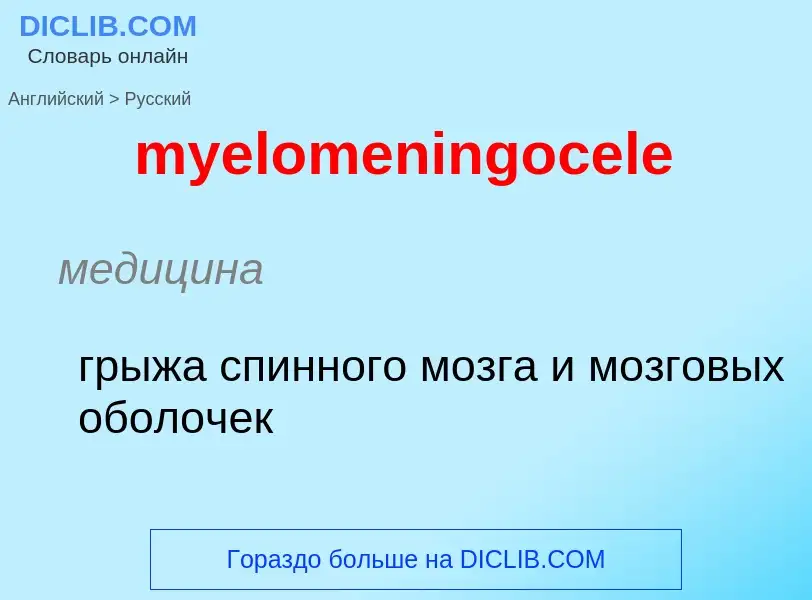Перевод и анализ слов искусственным интеллектом ChatGPT
На этой странице Вы можете получить подробный анализ слова или словосочетания, произведенный с помощью лучшей на сегодняшний день технологии искусственного интеллекта:
- как употребляется слово
- частота употребления
- используется оно чаще в устной или письменной речи
- варианты перевода слова
- примеры употребления (несколько фраз с переводом)
- этимология
myelomeningocele - перевод на русский
медицина
грыжа спинного мозга и мозговых оболочек
медицина
расщеплённый позвоночник
расщелина позвоночника
расщепление позвоночника
медицина
скрытое незаращение дужки позвонка
расщепление дужки позвонка
Определение
Википедия

Spina bifida /ˌspaɪnə ˈbɪfɪdə/ (Latin for 'split spine'; SB) is a birth defect in which there is incomplete closing of the spine and the membranes around the spinal cord during early development in pregnancy. There are three main types: spina bifida occulta, meningocele and myelomeningocele. Meningocele and myelomeningocele may be grouped as spina bifida cystica. The most common location is the lower back, but in rare cases it may be in the middle back or neck.
Occulta has no or only mild signs, which may include a hairy patch, dimple, dark spot or swelling on the back at the site of the gap in the spine. Meningocele typically causes mild problems, with a sac of fluid present at the gap in the spine. Myelomeningocele, also known as open spina bifida, is the most severe form. Problems associated with this form include poor ability to walk, impaired bladder or bowel control, accumulation of fluid in the brain (hydrocephalus), a tethered spinal cord and latex allergy. Learning problems are relatively uncommon.
Spina bifida is believed to be due to a combination of genetic and environmental factors. After having one child with the condition, or if one of the parents has the condition, there is a 4% chance that the next child will also be affected. Not having enough folate (vitamin B9) in the diet before and during pregnancy also plays a significant role. Other risk factors include certain antiseizure medications, obesity and poorly controlled diabetes. Diagnosis may occur either before or after a child is born. Before birth, if a blood test or amniocentesis finds a high level of alpha-fetoprotein (AFP), there is a higher risk of spina bifida. Ultrasound examination may also detect the problem. Medical imaging can confirm the diagnosis after birth. Spina bifida is a type of neural tube defect related to but distinct from other types such as anencephaly and encephalocele.
Most cases of spina bifida can be prevented if the mother gets enough folate before and during pregnancy. Adding folic acid to flour has been found to be effective for most women. Open spina bifida can be surgically closed before or after birth. A shunt may be needed in those with hydrocephalus, and a tethered spinal cord may be surgically repaired. Devices to help with movement such as crutches or wheelchairs may be useful. Urinary catheterization may also be needed.
Rates of other types of spina bifida vary significantly by country, from 0.1 to 5 per 1,000 births. On average, in developed countries, including the United States, it occurs in about 0.4 per 1,000 births. In India, it affects about 1.9 per 1,000 births. Europeans are at higher risk compared to Africans.




![[[X-ray computed tomography]] scan of unfused arch at C1 [[X-ray computed tomography]] scan of unfused arch at C1](https://commons.wikimedia.org/wiki/Special:FilePath/Atlasbogenspalt.jpg?width=200)
![Myelomeningocele in the lumbar area(1) External sac with [[cerebrospinal fluid]](2) Spinal cord wedged between the vertebrae Myelomeningocele in the lumbar area(1) External sac with [[cerebrospinal fluid]](2) Spinal cord wedged between the vertebrae](https://commons.wikimedia.org/wiki/Special:FilePath/Meningomyelocele diagram.jpg?width=200)
